
Hanging from the rafters of Le Petit-Courty, like an upside-down garden, Francisca dried plants, roots, and bark, ready for immediate use to treat whatever ailed the Cathillon family or the people of Vacquenoux.
Hemp-Agrimony

Of the myriad of species collected, she relied on Hemp-Agrimony above all others, collecting the leaves and flowering tops in August, before they opened and dried. Vitamin C in plants such as Hemp-Agrimony staved off scurvy and colds during the long Vosges winter without fresh fruits.
A tea made from Hemp-Agrimony leaves or dried flowers treated colds and sore throats, reduced fever, and relieved stomachaches. The bruised leaves applied directly to the skin healed wounds or infections, or rubbed on domestic animals repelled insects. Placing the leaves in a bath relieved aching muscles and joints and a compress of the leaves relieved headaches. Even the roots from the plant were used as a laxative.
Commonly found in wet soil near swamps and thickets or along freshwater streams, Hemp-Agrimony is a tall woody plant, growing between two and five feet high with long, toothy leaflets. The leaves grow in familiar tiered hemp-style in pairs of three lobes. Reddish stems covered in downy hair with clusters of tiny pink or white flowers that burst forth from July to September.
Hemp-Agrimony is no relation to Agrimony, a plant with yellow flowers, nor is it related to Cannabis Hemp, though the shape of the leaf is similar. All parts of the this is poisonous if eaten and should only be ingested as a tea.
Source: Weiner, Michael A., Earth Medicine, Earth Food. MacMillan Publishing Co, Inc. (1980) Print